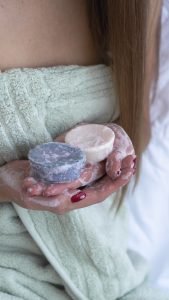Listen, we fully understand. When you use liquid shampoo and conditioner all of your life, it’s hard to imagine that these tiny blocks will be effective or have much of an impact on your hair.
Nothing makes us happier than converting doubters into believers, so let’s get started by dispelling the top 5 myths regarding shampoo and conditioner bars!
Solid bars are too hard to use !
There are benefits to being honest. The days of tripping over slippery bottles and messy spills in the shower and in your travel bag are long gone. But what are solid shampoo and conditioner bars like to use in real life? Though it might appear intimidating, we assure you that it’s simple.
We always advise swiping your shampoo and conditioner bars immediately onto your hair rather than rubbing them onto your hands first.
As usual, begin by starting with wet hair before shampooing or conditioning. The water from your shower or bath is especially important here because there is no water in our bars.
- Slide the bar along your head and hair – they’re super concentrated, so just a few swipes should do it.
- Then, put the bars down and lather up (shampoo) or comb the product through (conditioner) your hair with your fingers.
- Simply rinse, dry, and feel the magic. Easy peasy!
Shampoo bars have little to no lather.
Not at all! To be clear, though, there is no correlation between the amount of lather and how well your hair is being cleansed.
Ruh shampoo bars effectively cleanse hair without robbing it of moisture by using mild surfactants. There are bars for all hair kinds, including curly hair and alternatives for bringing out the best in blonde and gray hair owing to a purple toning spectrum. There are bars for all hair types, including fine to coarse, oily to dry.
The shampoo bars will dry my hair.
Your hair won’t get as dry with a pH-balanced, soap-free shampoo bar as opposed to a liquid shampoo with the same active components.
The same nourishing and conditioning components that are included in liquid shampoos, like as cocoa butter, coconut oil, and behentrimonium methosulfate (BTMS), can be used to create shampoo bars.
The outcomes would be comparable if we conducted a like-to-like comparison of a shampoo bar and a shampoo liquid with the same surfactants (whether it be sodium coco sulfate, or alternative sulfate-free surfactants).
The pH of the product is perhaps the most important difference between a shampoo bar and a soap bar (and the one that causes the most confusion). Many of the good hair care bars on the market are actually soap bars, not shampoo. The normal pH of human hair is 4-5, which is incompatible with soap’s high (alkaline) pH of over 8. Because the pH of the soap bar and that of hair are incompatible, damage to the cuticle might result, leaving hair feeling dry and damaged. On strands, a waxy soap residue can also develop.
Ruh shampoo bars are actually shampoo; they simply don’t contain the 60–80% water that most liquid shampoos do. They have a pH balance between 4-5, are soap-free, and are packed with nourishing and conditioning elements to make hair feel and look its best.
The bars won’t last long
A major WRONG! Although the shampoo bars are considerably smaller than those enormous bottles of shampoo, they can be used for months before needing to be replaced.
Our conditioner bar is equivalent to 3 x 350ml bottles of liquid conditioner, while our shampoo bars are similar to 2 x 350ml bottles of liquid shampoo.
Therefore, based solely on attention, they ought to last you forever.
The bars are so messy.
Contrarily, many of our clients comment on how much cleaner their showers are now that the bottles aren’t taking up space on the floor and shelves.
There you have it, then! The five most frequent myths regarding our shampoo and conditioner bars debunked. Would you like to test it? Browse our selection to find the ideal shampoo bar for your hair.



